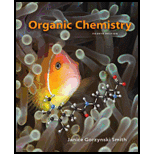
Concept explainers
Recall from section 1.10B that there is restricted rotation around carbon-carbon double
bonds. Maleic acid and fumaric acid are two isomers with vasity different physical properties and

maleic acid fumaric acid
Want to see the full answer?
Check out a sample textbook solution
Chapter 3 Solutions
Organic Chemistry
- 16-17 Propylamine (bp 48°C), ethylmethylamine (bp 37°C), and trimethylamine (bp 3°C) are constitutional isomers with the molecular formula C3HgN. Account for the fact that trimethylamine has the lowest boiling point of the three and propylamine has the highest.arrow_forwardLinolenic acid (Table 10.2) and stearidonic acid are omega-3 fatty acids, unsaturated fatty acids that contain the first double bond located at C3, when numbering begins at the methyl end of the chain. Predict how the melting point of stearidonic acid compares with the melting points of linolenic and stearic acids. A current avenue of research is examining the use of soybean oil enriched in stearidonic acid as a healthier alternative to vegetable oils that contain fewer degrees of unsaturation.arrow_forwardAnswer the following questions by referring to the ball-and-stick model of fentanyl, a potent narcotic analgesic used in surgical procedures. a. Identify the functional groups. b. Label the most acidic proton. c. Label the most basic atom. d. What types of intermolecular forces are present between two molecules of fentanyl? e. Draw an isomer predicted to have a higher boiling point. f. Which sites in the molecule can hydrogen bond to water? g. Label all electrophilic carbons.arrow_forward
- Answer the following questions by referring to the ball-and-stick model of fentanyl, a potent narcotic analgesic used in surgical procedures.a.Identify the functional groups. b. Label the most acidic proton. c.Label the most basic atom. d.What types of intermolecular forces are present between two molecules of fentanyl? e.Draw an isomer predicted to have a higher boiling point. f.Which sites in the molecule can hydrogen bond to water? g.Label all electrophilic carbons.arrow_forward1. Explain the following - why stearic acid has higher melting point than decanoic acid. - why benzoic acid has higher melting point than stearic acid. - why salicylic acid has higher melting point than benzoic acid. - why octane has a higher melting point than isooctane. - why 2,2,3,3-tetramethylbutane has the highest melting point among the three isomers of C8H18.arrow_forward1) What are isomers of haxane.Arrange the isomers in order of increasing boiling points.arrow_forward
- Rank from least polar (1) to most polar (6): Baby oil, Pure Water, 70% isopropyl alcohol, Dried isopropyl alcohol, Isopropyl alcohol with some baby oil, and saltwater.arrow_forwardDoes alcohol, ketones, and aldehydes considered acidic or a basic?arrow_forwardA carboxylic acid has two oxygen atoms, each with two nonbonding pairs of electrons.(a) Draw the resonance forms of a carboxylic acid that is protonated on the hydroxyoxygen atom.arrow_forward
- 3. a. What is the chemical structure of benzoic acid, circle functional groups different than alkane,alkene, alkyne? b. Is it polar or nonpolar? _______________________ c. What is its water solubility in g/L? __________________________arrow_forwarda. What is the chemical structure of 2,6-dichloroindophenol, circle functional groups differentthan alkane, alkene, alkyne? b. Is it polar or nonpolar? _______________________ c. What is its water solubility in g/L? ___________arrow_forwardWhich of the following is the most basic? HCOOH Ka=1.77 x 10⁻⁴ CH₃CH₂COOH Ka=1.34 x 10⁻⁵ HN₃ Ka=1.9 x 10⁻⁵ C₆H₅OH Ka=1.6 x 10⁻¹⁰arrow_forward
 Introduction to General, Organic and BiochemistryChemistryISBN:9781285869759Author:Frederick A. Bettelheim, William H. Brown, Mary K. Campbell, Shawn O. Farrell, Omar TorresPublisher:Cengage Learning
Introduction to General, Organic and BiochemistryChemistryISBN:9781285869759Author:Frederick A. Bettelheim, William H. Brown, Mary K. Campbell, Shawn O. Farrell, Omar TorresPublisher:Cengage Learning Introductory Chemistry: A FoundationChemistryISBN:9781337399425Author:Steven S. Zumdahl, Donald J. DeCostePublisher:Cengage Learning
Introductory Chemistry: A FoundationChemistryISBN:9781337399425Author:Steven S. Zumdahl, Donald J. DeCostePublisher:Cengage Learning Chemistry: The Molecular ScienceChemistryISBN:9781285199047Author:John W. Moore, Conrad L. StanitskiPublisher:Cengage Learning
Chemistry: The Molecular ScienceChemistryISBN:9781285199047Author:John W. Moore, Conrad L. StanitskiPublisher:Cengage Learning Chemistry: An Atoms First ApproachChemistryISBN:9781305079243Author:Steven S. Zumdahl, Susan A. ZumdahlPublisher:Cengage Learning
Chemistry: An Atoms First ApproachChemistryISBN:9781305079243Author:Steven S. Zumdahl, Susan A. ZumdahlPublisher:Cengage Learning



